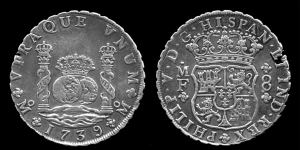Important Dates in the Monetary History of the United States, Part I: 1606 to 1776 – Colonial Era
By David Liechty
Prior to the signing of the Declaration of Independence, the American Colonies were subject to the rule of English Common Law and pronouncements of the English Crown and Parliament. Charters from the English Government delineated legal powers granted to the colonies, and at least one, Virginia’s Charter of 1606 , gave that colony the power to coin its own money. Others, however, did not have this power, and it was Massachusetts’ 1652 establishment of a mint, for example, that led in part to revocation of its Charter in 1684 and closure of the mint in 1688.
English Common Law at this time, and up until 1816, required English government coin to be of precious metal (gold or silver) regulated, in terms of weight and fineness, against a “sterling” standard. Silver coin of a specific weight (one “pound”) and fineness (92.5% silver) was set as the “sterling metal” against which all other coin, foreign and domestic, was compared and valued. Silver coin was kept at a constant value, while the issue of gold coin fluctuated in denomination with changes in the relative market value of gold. This bimetallic system was followed in England from 1603 until 1816. In 1672, the English government first issued copper farthings and half-pence, which were treated differently under the common law.
This English Government-issued coin was only one medium of exchange used in the colonies, however, and was relatively scarce. The American colonists utilized a wide range of foreign coin, as well, and given the amount of trade with Spanish Colonies in the Americas, the Spanish milled dollar, or “Piece of Eight” became ubiquitous throughout, with Virginia establishing it as the standard of its colonial currency as early as 1645.
The American colonists also utilized commodity money-substitutes such as tobacco, wampum, corn, bullets, and livestock, which often circulated within the colonies in the form of warehouse receipts. “Book credit” was also common, wherein merchants would extend credit to other merchants, artisans, and farmers.
The various Colonial Governments also issued paper currencies, termed “bills of credit.” In 1690, Massachusetts issued £7,000 of “indented” bills of credit , the first such issuance in the Colonies, and said to be the origin of paper currency in the British Empire. As these bills of credit devalued against the English Pound, Massachusetts passed a law declaring them legal tender, requiring that they “pass current … in all payments equivalent to money.” Another first, the devaluating currency was foisted upon the public. Bills of credit in the Colonies were not fiat money, as they had substantive backing, issued usually in one of two ways.
In the first, government land banks or loan offices issued paper currency as loans secured by mortgages. In the second, governments paid on-going government expenses with bills of credit which they pledged to redeem using future tax receipts. These bills of credit had arguably beneficial effects on the Colonial economies, but devaluation against the English Pound was a common element to all of them.
Between 1720 and 1774, for example, devaluation of the Colonial currencies ranged from 12-13% in New York and Virginia up to 1,340% in Rhode Island. The relative rates of devaluation led to great friction between merchants in various Colonies, most notably between Connecticut and Rhode Island, as seen in some of the writings of Roger Sherman.
In 1751 and 1764 the English Parliament passed acts restricting the issuance of Colonial bills of credit, but this legislation met with fierce resistance in the Colonies. Bills of credit were seen by some parties to be essential to their economic success, and the Colonies found ways around the Parliamentary prohibitions, and continued to issue bills of credit.
The 1764 legislation curtailing bills of credit was seen by many, including Benjamin Franklin, to be a major cause of the American Revolution .
David Liechty is an attorney who is currently studying for a Phd in Constitution Studies. He is interning with Solari this summer.
See Parts (I), (II), (III), (IV),(V), (VI), (VII), (VIII) and (IX)



i think another important date would be june 25 1775 when the Continental congress issued Continentals. 2 million dollars were issued on a regular basis, counterfeited frequently and inflationary usually. Paul Revere engraved them and Ben Franklin printed them. think about it.
heather
Colonial currency wasn’t devalued because of British counterfeiting – that was the Continentals later. I’ve not read Ellen Brown’s book, but plan to look at it soon.
Thanks for the comments.
I’m with Skip.
Here’s the quote:
This phenomenon can best be demonstrated by the famous story of Joseph’s penny: If Joseph the father of Jesus had invested one penny at his birth at 5% interest and Jesus returned to the same bank in 1990 – with the money accrued in the meantime he would have been able to buy 134 billion balls of gold of the weight of the Earth based on the official price of gold at this time. This shows mathematically that the continual payment of interest and compound interest over a longer period of time is practically impossible and explains why – at regular intervals – we have economic and social breakdowns, social revolutions or war.
(from http://le.org.nz/tiki-index.php?page=BasicMisconceptions )
And as I posted in part II, everyone should read this Stephen Zarlenga article:
http://www.monetary.org/briefusmonetaryhistory.htm
President John F. Kennedy, The Federal Reserve and Executive Order 11110
http://www.real-debt-elimination.com/real_money/jfk_and_executive_order_11110.htm
Ellen Brown is also a gold bug. However, she thinks that gold and silver is a commodity with a very volatile price tag. Not the type of thing you want to base your currency on, assuming you want a stable currency. She also says that if gold were the official money, that the fractional reserve banking system will allow the private banksters to acquire all of it over time, since there is only a finite amount of it in the world. It’s like that study done many years ago by someone mentioned in her book. If you took out a loan of one penny at 5% interest at the year 0 AD, the amount of gold owed in interest today would amount to (I forget the number) hundreds or thousands of globes of gold the size of planet earth through the “miracle” of compound interest.
Steven Zarlenga’s The Lost Science of Money is another interesting read. He says up front that he is for any money system that has proven itself throughout time. Our parasitic system is not such a system.
Yes, yes! Please go on!
I’m sold on Ellen Brown’s debt-free money theories. Please tell me why all the gold/silver bugs (like myself) think she is wrong. I can’t get a straight answer.
Governments will create too much i am told. True enough. But that is happening NOW and it is being created as debt to private world oligarchs.
http://www.WebOfDebt.com
I hope that I am not breaching protocol by posting a comment that is not directly related to the subject at hand. But, since all of the posts are related to the tapeworm economy in one way or another, I thought that other Solari readers might find the following expose elucidating.
At the bottom is a link to an incredible work of investigative journalism from DeepCapture.com
In it is explained the relationship of various hedge funds, the mafia, and media outlets, particularly with reference to the practice of naked short selling. This piece is truly expansive. It is the most comprehensive investigation of this subject that I have read. While this is of obvious interest to Solari readers who are trying to understand tapeworm economics, the article also gives further evidence of foreknowledge regarding the attacks of 911.
http://www.deepcapture.com/the-story-of-deep-capture-by-mark-mitchell/
wasn’t it devalued because the britts made a lot of counterfeit bills and because of speculators of currencies. Ellen Brown writes about this in her book the “Web Of Debt”.Great read by the way she also thinks California and other states can solve their credit problems by creating a state bank to issue credit like North Dakota does now.
Barry
An interesting quote by Benjamin Franklin…
“We would gladly have borne the tax on tea if we could have been granted the power to create our own money.” pg. 41 Cantelon
Apparantly George 111 wasn’t to thrilled with the idea.